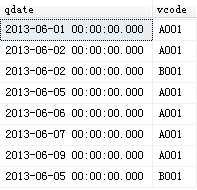create table tmptable(rq datetime) go insert tmptable values('2010.1.1') insert tmptable values('2010.1.2') insert tmptable values('2010.1.3') insert tmptable values('2010.1.6') insert tmptable values('2010.1.7') insert tmptable values('2010.1.10') insert tmptable values('2010.1.11') insert tmptable values('2010.1.12') insert tmptable values('2010.1.19') insert tmptable values('2010.1.20') insert tmptable values('2010.1.22') insert tmptable values('2010.1.23') insert tmptable values('2010.1.28') go ---希望得到的结果 --本期起始日期 本期终止日期 持续天数 距上一期天数 --2010.1.1 2010.1.3 3 0 --2010.1.6 2010.1.7 2 3 --2010.1.10 2010.1.12 3 3 --2010.1.19 2010.1.20 2 7 --2010.1.22 2010.1.23 2 2 --2010.1.28 2010.1.28 1 5 SELECT 本期起始日期 = MIN(rq) , 本期终止日期 = MAX(rq) , 持续天数 = MAX(id1) - MIN(id1) + 1 , 距上一期天数 = CASE a.id1 - a.id2 WHEN -1 THEN 0 ELSE MAX(datediff(d, rq2, rq)) END FROM ( SELECT id1 = datediff(d, '2010-01-01', rq) , id2 = ( SELECT COUNT(1) FROM tmptable WHERE rq <= a.rq ), rq2 = ( SELECT MAX(rq) FROM tmptable WHERE rq < a.rq ) , * FROM tmptable a ) a GROUP BY a.id1 - a.id2 /* 本期起始日期 本期终止日期 持续天数 距上一期天数 ----------------------- ----------------------- ----------- ----------- 2010-01-01 00:00:00.000 2010-01-03 00:00:00.000 3 0 2010-01-06 00:00:00.000 2010-01-07 00:00:00.000 2 3 2010-01-10 00:00:00.000 2010-01-12 00:00:00.000 3 3 2010-01-19 00:00:00.000 2010-01-20 00:00:00.000 2 7 2010-01-22 00:00:00.000 2010-01-23 00:00:00.000 2 2 2010-01-28 00:00:00.000 2010-01-28 00:00:00.000 1 5 警告: 聚合或其他 SET 操作消除了空值。 (6 行受影响) */
例2:
create table t (qdate datetime,vcode varchar(50)); insert into t values('2013-06-01','A001'); insert into t values('2013-06-02','A001'); insert into t values('2013-06-02','B001'); insert into t values('2013-06-05','A001');
生成表如下:

按照vcode进行分组,按照qdate进行降序排列,记录行号rn
select *,ROW_NUMBER() over (partition by vcode order by qdate desc ) as rn from [my_exercise].[dbo].[t]
将日期减去行号,得到的结果rn连续相同时即为时间连续组
select *, (day(qdate) - row_number() over(partition by t.vcode order by t.qdate))rn from [my_exercise].[dbo].[t]
根据vcode和rn分组,得到的count即为连续的天数
select vcode,rn,count(*)as count from ( select t.*,(day(t.qdate) - row_number()over(partition by t.vcode order by t.qdate)) rn from [my_exercise].[dbo].[t]) a group by vcode, rn
通过having即可筛选出连续天数>=3的vcode
select vcode,rn,count(*)as count from ( select t.*,(day(t.qdate) - row_number()over(partition by t.vcode order by t.qdate)) rn from [my_exercise].[dbo].[t]) a group by vcode, rn having count(1)>=3